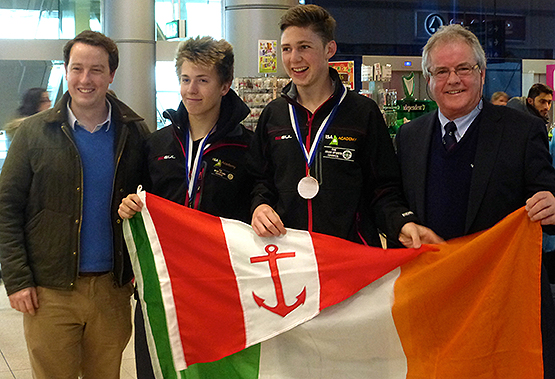As a vehicle sport dominated by weather conditions, sailing can be difficult enough to explain to the outside world. But when you factor in the constantly changing situation which is youth sailing, where crew dynamics of size, weight and attitude can change with bewildering rapidity, it becomes very complex indeed.
Yet despite the inevitable fluidity, Ireland has long had a vibrant youth sailing scene. And it’s on a roll right now, with the Irish crew of Doug Elmes and Colin O’Sullivan returning this week from the Youth Worlds on the other side of the planet with a Bronze Medal in the 420, while the bonus is that all of the team of four came home from the championship with very solid performances recorded. Liam Glynn returned with 15th out of a fleet of 66 in the Laser Radial Boys, while Aisling Keller was tenth out of 55, also in Laser Radial. W M Nixon tries to capture the mood of the moment, and the machinations behind the 420 crew’s special success.
It could well be that there was only a window of opportunity of maybe six months or even less in which Doug Elmes of Kilkenny and Colin O’Sullivan of Malahide could have been realistically in the frame for a podium place racing the 420 in the Youth Sailing World at Langkawi in Malaysia in the final week of 2015.
The 420 is a gallant little boat, but young sailors outgrow them very quickly. And then before you know it, they’re too old anyway. Elmes, who is now 17, and O’Sullivan, who will become 17 in March, have known each other, and got on well together, since they first met while racing Optimists when aged eleven. But it wasn’t automatic that they should team up to sail 420s, instead of choosing the usual solo junior sailing career path of going on to maybe a year or two in Toppers, and then on into the Laser.
Sailing pundits bewail the fact that our junior sailing is dominated by single-handed boats. But the logistics of campaigning a two-person boat on the national and international circuit at junior level are extremely challenging. The most basic problem is that neither crewmember will have a driving licence. Thus they’re totally reliant on family or organisational support for boat movement, and in the end it almost invariably means that two families will be totally involved.
The level of mutual goodwill required across the generations and between at least two households is extremely high, so it’s not surprising that ISA Coach Ross Killian – he marks ten years as a fulltime sailing coach this year – reckons that a realistic figure for the Irish 420 fleet with genuine potential hovers around the 15 mark, and the going is good when the number of serious participants gets up to 20 boats.
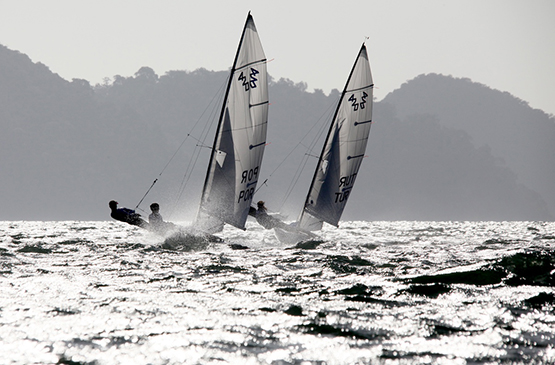
A sailing paradise. The Portuguese and Turkish crews revelling in the perfect 420 sailing conditions at Langkawi.

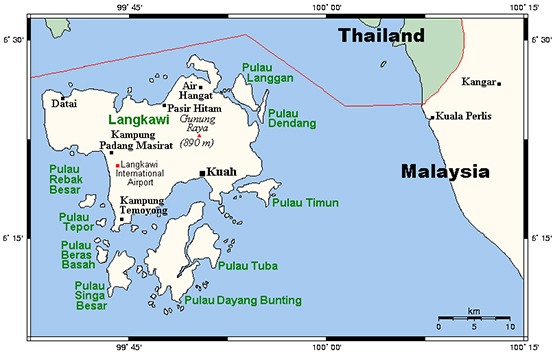
The paradise island provided one problem - getting the boats delivered there had a significant “Just In Time” aspect.
In such a small fleet, inevitably the volunteer administrative work will fall to a few. You get a notion of the compact size of the national operation when you realize that the Irish President is John Elmes of Waterford Harbour SC in Dunmore East, who also happens to be Doug Elmes’ father, while the Class Secretary is Joan O’Sullivan of Malahide who – you’ve guessed it – is Colin O’Sullivan’s mum.
Yet as regular Afloat.ie watchers will be well aware, on Tuesday when the successful team returned to a rapturous welcome in Dublin Airport, the 420 crew found themselves immediately wrapped in the tricolour and the Howth YC burgee, and it’s in the Howth club tomorrow that they’ll be officially welcomed home.
This neatly illustrates the fact that the Irish 420 focal point is a moveable feast. For now at any rate, it’s Howth which happens to be providing the national centre. It is currently coming up with the numbers, and in club coach Graeme Grant it has one very talented individual who inspires the young people to reach the level at which they can be taken under Ross Killian’s wing for the international circuit.
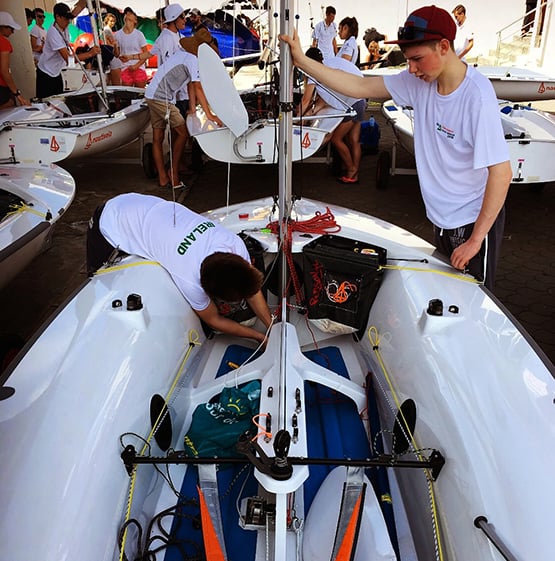
Colin O’Sullivan holds the mast in place as the 420s are rigged and Doug Elmes turns his skills to sorting a technical problem on the boat, which was delivered to the venue at the last moment. Photo: Ross Killian
But it’s a matter of catching the talent when all the stars have the potential to be in alignment, and in the final analysis it’s the young crews themselves who have to show the spark that will be fanned into the flame of success.
Of the successful crew, it was Colin O’Sullivan who first felt the 420 urge. He remembers it very well. He was thirteen-and-a-half at the time, and though he could have had another couple of years with the Optimists, he was growing tall, and so he got involved with 420 sailing, crewing for Ewan McMahon of Howth.
Meanwhile Doug Elmes – who had been concentrating on sailing Optimists at Crosshaven with the RCYC - was soon feeling the same way, and he in turn teamed up to move on to 420 racing with Bill Staunton of Skerries, which tells us something of the truly national nature of Optimist racing.
But when we look at the 420 in detail, it’s to realise that while she’s a very serviceable little boat, the fact that she’s precisely and only 4.2 metres long makes it inevitable that with today’s bigger and faster-growing youngsters, their 420 compatibility period can be very brief indeed, and they have to keep an eye out for potential new crewmates.
Thus when MacMahon and Staunton outgrew the 420, Elmes and O’Sullivan decided to become a crew, and their debut together was at Wexford in September 2014. They’ve been fine-tuning their act ever since, with the busy little class at Howth providing the stage, and they make for a very balanced duo in a boat which is central to world youth sailing.
The virtue of the 420 is that she’s as small and economical as you can get while still having the crew on a trapeze. The boat has been around for more than half a century now, having been designed by Christian Maury to a specification devised by the chief instructors at a sailing school in southwest France. But as she’s one of those boats that looks much better when fully alive and sailing well than she does on the plans, it took a long time in the 1970s before anyone in Ireland would accept the contention, put forward by Sean Clune of the National YC, that the 420 was the only way to go for Irish junior sailing.
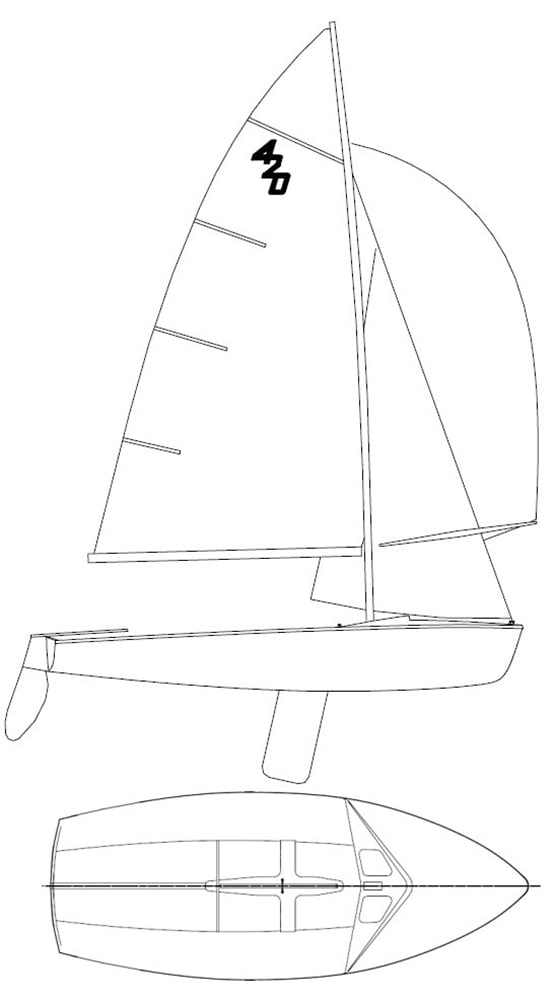
The International 420 is one of those boats which looks better when she’s sailing (below) than she does on the plans (above)

But for those young people who wanted a boat which was minimum hassle to maintain yet providing a proper grown-up sailing experience, the 420 was the future here and now, and it has the advantage of being family-friendly in that, though you’ll need the help of your folks to get the boat to a championship destination, they won’t have to shell out on a 4X4 for a towing vehicle, while it has long been a class tradition that at major international events, the host nation has to provide boats.
So all you have to do is provide the talent and the dedication……Well, there’s more to it than that, of course. But for now, let’s just celebrate the fact that a young sailor from Ireland’s only significant inland town which is not an official waterways port, teamed up moreover with another young sailor who learned his skills on the unique Broadmeadow Water at Malahide, has done the business on the sunny seas of southeast Asia with coolness and style.
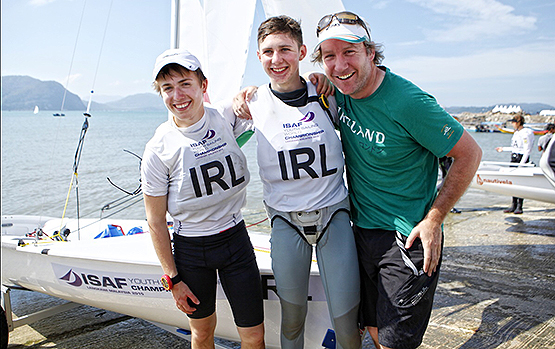
The job done – with their Bronze Medal secured, Doug & Colin get together with coach Ross Killian.
It was classic stuff. As Graeme Grant says of their development: “They have been always improving results and skills through dedication and hard work”. And as Ross Killian attests: “They’re just so cool under pressure, and they balance each other”.
As Colin O’Sullivan loyally asserts, it’s Doug Elmes who is the techno-genius. They arrived in the island of Langkawi to find paradise and perfect sailing conditions – but no boats. There’d been a foul-up in the fleet delivery schedule. The boats arrived at the last minute, so the trial race was the very first sail. But Doug was in his element putting it all together, and their boat was as race prepared as any in the fleet.
As the series progressed, it came down to the wire for the Bronze Medal between Ireland and Australia. In the crucial race, it was the Australian coach who commented to Ross Killian on the stylish coolness of the Irish crew, and watched in open-mouthed admiration as Elmes carried off a mark-rounding with such skill that he picked up three places at a stroke.
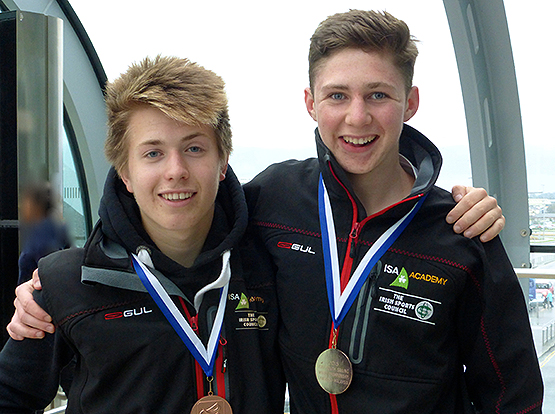
Thereafter, the commentators on the shared coach-boat were favourably impressed by the way the Irish kept the race and their place under quiet yet total control, avoiding the temptation to throw everything away by being unnecessarily greedy.
The day after their return to Ireland, we spoke with Colin O’Sullivan after he’d done some serious catching-up on sleep, yet with typical dedication had dragged himself out into the winter night for his routine session at the gym. The big question with a crew of two is how much they talk during a race. The answer in this case is that since teaming up less than 18 months ago, the Elmes-O’Sullivan crew have upped the talk level with every event, yet it has become more focused each time out. “At Langkawi, we were exchanging information all the time, the talk was constant” says O’Sullivan with a chuckle, “but you definitely wouldn’t call it chat”.
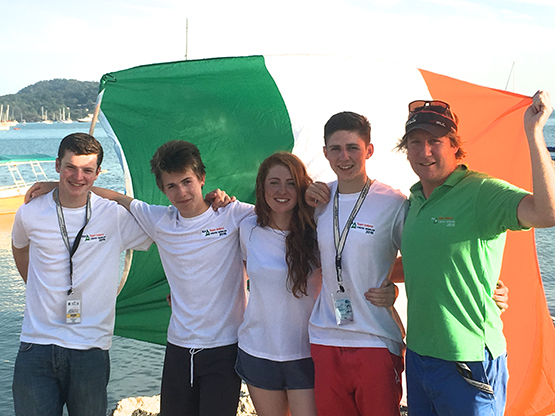
At the conclusion of a good Youth Worlds for Ireland are (left to right) Liam Glynn, Doug Elmes, Aisling Keller, Colin O’Sullivan and Ross Killian.
